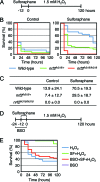Genetic evidence of an evolutionarily conserved role for Nrf2 in the protection against oxidative stress
- PMID: 22949501
- PMCID: PMC3486152
- DOI: 10.1128/MCB.00481-12
Genetic evidence of an evolutionarily conserved role for Nrf2 in the protection against oxidative stress
Abstract
Transcription factor Nrf2 is considered a master regulator of antioxidant defense in mammals. However, it is unclear whether this concept is applicable to nonmammalian vertebrates, because no animal model other than Nrf2 knockout mice has been generated to examine the effects of Nrf2 deficiency. Here, we characterized a recessive loss-of-function mutant of Nrf2 (nrf2(fh318)) in a lower vertebrate, the zebrafish (Danio rerio). In keeping with the findings in the mouse model, nrf2(fh318) mutants exhibited reduced induction of the Nrf2 target genes in response to oxidative stress and electrophiles but were viable and fertile, and their embryos developed normally. The nrf2(fh318) larvae displayed enhanced sensitivity to oxidative stress and electrophiles, especially peroxides, and pretreatment with an Nrf2-activating compound, sulforaphane, decreased peroxide-induced lethality in the wild type but not nrf2(fh318) mutants, indicating that resistance to oxidative stress is highly dependent on Nrf2 functions. These results reveal an evolutionarily conserved role of vertebrate Nrf2 in protection against oxidative stress. Interestingly, there were no significant differences between wild-type and nrf2(fh318) larvae with regard to their sensitivity to superoxide and singlet oxygen generators, suggesting that the importance of Nrf2 in oxidative stress protection varies based on the type of reactive oxygen species (ROS).
Figures




Similar articles
-
Regulation of Ahr signaling by Nrf2 during development: Effects of Nrf2a deficiency on PCB126 embryotoxicity in zebrafish (Danio rerio).Aquat Toxicol. 2015 Oct;167:157-71. doi: 10.1016/j.aquatox.2015.08.002. Epub 2015 Aug 13. Aquat Toxicol. 2015. PMID: 26325326 Free PMC article.
-
Generation and characterization of keap1a- and keap1b-knockout zebrafish.Redox Biol. 2020 Sep;36:101667. doi: 10.1016/j.redox.2020.101667. Epub 2020 Aug 11. Redox Biol. 2020. PMID: 32828016 Free PMC article.
-
Nrf2 activation attenuates genetic endoplasmic reticulum stress induced by a mutation in the phosphomannomutase 2 gene in zebrafish.Proc Natl Acad Sci U S A. 2018 Mar 13;115(11):2758-2763. doi: 10.1073/pnas.1714056115. Epub 2018 Feb 22. Proc Natl Acad Sci U S A. 2018. PMID: 29472449 Free PMC article.
-
Nrf2 and Nrf2-related proteins in development and developmental toxicity: Insights from studies in zebrafish (Danio rerio).Free Radic Biol Med. 2015 Nov;88(Pt B):275-289. doi: 10.1016/j.freeradbiomed.2015.06.022. Epub 2015 Jun 28. Free Radic Biol Med. 2015. PMID: 26130508 Free PMC article. Review.
-
Emerging applications for zebrafish as a model organism to study oxidative mechanisms and their roles in inflammation and vascular accumulation of oxidized lipids.Free Radic Biol Med. 2012 Oct 1;53(7):1411-20. doi: 10.1016/j.freeradbiomed.2012.08.004. Epub 2012 Aug 11. Free Radic Biol Med. 2012. PMID: 22906686 Free PMC article. Review.
Cited by
-
Diet affects the redox system in developing Atlantic cod (Gadus morhua) larvae.Redox Biol. 2015 Aug;5:308-318. doi: 10.1016/j.redox.2015.06.003. Epub 2015 Jun 12. Redox Biol. 2015. PMID: 26099546 Free PMC article.
-
Protective effects of resveratrol against 5-fluorouracil-induced oxidative stress and inflammatory responses in human keratinocytes.J Clin Biochem Nutr. 2021 Nov;69(3):238-246. doi: 10.3164/jcbn.21-23. Epub 2021 Oct 2. J Clin Biochem Nutr. 2021. PMID: 34857985 Free PMC article.
-
Conservation of the Keap1-Nrf2 System: An Evolutionary Journey through Stressful Space and Time.Molecules. 2017 Mar 9;22(3):436. doi: 10.3390/molecules22030436. Molecules. 2017. PMID: 28282941 Free PMC article. Review.
-
Embryonic exposure to Mono(2-ethylhexyl) phthalate (MEHP) disrupts pancreatic organogenesis in zebrafish (Danio rerio).Chemosphere. 2018 Mar;195:498-507. doi: 10.1016/j.chemosphere.2017.12.094. Epub 2017 Dec 15. Chemosphere. 2018. PMID: 29277029 Free PMC article.
-
Exercise, Nrf2 and Antioxidant Signaling in Cardiac Aging.Front Physiol. 2016 Jun 17;7:241. doi: 10.3389/fphys.2016.00241. eCollection 2016. Front Physiol. 2016. PMID: 27378947 Free PMC article. Review.
References
-
- Aleström P, Holter JL, Nourizadeh-Lillabadi R. 2006. Zebrafish in functional genomics and aquatic biomedicine. Trends Biotechnol. 24:15–21 - PubMed
-
- Anderson ME. 1998. Glutathione: an overview of biosynthesis and modulation. Chem. Biol. Interact. 111–112:1–14 - PubMed
-
- Berggren MI, et al. 2001. Thioredoxin peroxidase-1 (peroxiredoxin-1) is increased in thioredoxin-1 transfected cells and results in enhanced protection against apoptosis caused by hydrogen peroxide but not by other agents including dexamethasone, etoposide, and doxorubicin. Arch. Biochem. Biophys. 392:103–109 - PubMed
-
- Bowerman B, Eaton BA, Priess JR. 1992. skn-1, a maternally expressed gene required to specify the fate of ventral blastomeres in the early C. elegans embryo. Cell 68:1061–1075 - PubMed
Publication types
MeSH terms
Substances
Grants and funding
LinkOut - more resources
Full Text Sources
Molecular Biology Databases
